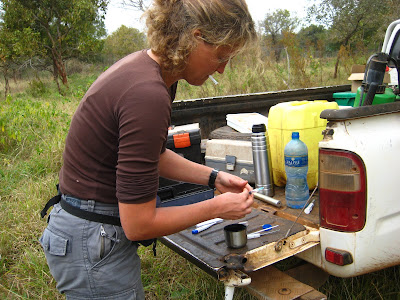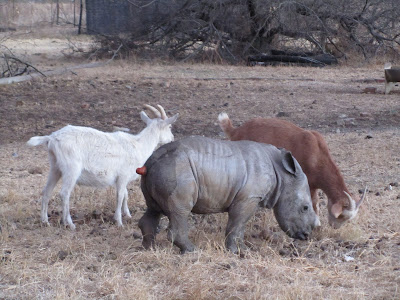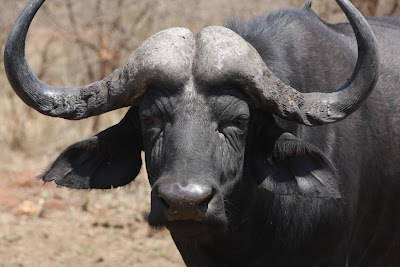


Had again a very interesting day! To be honest, almost every day is exciting and interesting. Each morning waking up grateful to be able to work with such special animals and to take the challenge of immobilizing and treating them. This 2 year old rhino young bull was seen with a swollen eye with discharge for a month or so and it did not seem to improve. Also, his mother just got a new baby and rejected him, so he was unhappy and sad. White rhinos are so sensitive and social that they can be depressed for months when this happens. Sadly there are not other 2 year old weaners in this part of the park to join up with, so he must feel lonely, the poor boy.
We decided to dart him to examin his eye to see how bad the injury was and whether there was something I could do for him to make his life a bit better.
But...easier said than done.
We drove to the spot where we saw him the day before. Because it was so hot (38 degrees or so) I decided to wait one day. Rhinos are very sensitive for heat, so it's better not to immobilize them in hot weather. Especially when wild animals are running in hot weather, the hyperthermia can even kill them.
After a stunning hour drive in that area, through mountains, trees and hills, we saw him running around on his own. When he saw us, he took off! He clearly knew we were looking for him. Therefore I decided to track him on foot. The most important thing is to track him off wind, because rhinos do smell very well. On top of this, you must stand frozen still when he looks at you, because they only see movements. Together with silence, it's possible to approach a wild rhino at 20 meters or so. But...unfortunately not the clever and suspicious ones. Tracked and tracked him, walking as quiet as possible, but this boy run already at 50 meters, too far to dart him through the bush. As I did not like him running around too much, it was getting late (you never want to dart a wild animal later than 2 hour before dark, because you MUST always be able to find it when asleep) and it clearly was not that an emergency, I decided to try again the next morning.
The next morning at 6.30 am he was quiet and standing under a tree. Was this the same animal as yesterday?? The swollen, closed left eye made it clear indeed. The darting was easy and it was nice cool. Five minutes after darting he fell into 'dog-sit' position: stretched frontlegs and sitting on his hindlegs. It is very bad for rhinos to sit like this, so I put the blind fold on and pushed him on one side. Luckily the trackers arrived to help me to push him back on his belly. Then I injected some respiration stimulans in his vene. This is a routine procedure in white rhinos, because they are very sensitive for etorphine (an opioid used for the immobilization), what causes respiration depression. I checked his ear venes, a good way to check the blood pressure, respiration rate and heart rate. When the anesthesia was steady I focused on his left eye. Flushed it with sterile Ringers fluids and found an old wound in the eye, likely caused by a thorn or horn: the iris, cornea and bulb were damaged and it had developed a lens catharact. Unfortunately this kind of severe eye damage are likely to be permanent. Will also send the picture to some eye specialised vets; maybe they are happy to do a lens extraction in this rhino? Often specialists are more than happy to take challenges what gets them into the field. Will see! I applied eye cream, systemic antibiotics and a painkiller. Unfortunately this was all I could do for him at this stage. Luckily rhinos don't use their eyes as much as we do and he should be able to have a fairly normal rhino life. I injected the full anti-dote in the ear vene. He woke up in 1.30 minute and walked away as if nothing happened. Let's hope he finds a friend soon!


 Got such a nice present last week (experience every sight of a wild animal as a special present, as these animals decide to show themselves or not). I often visit the Kruger NP only for 2 hours or so, after work. Yes, I know, it's a luxery to live so close to the world most famous National Park. I was on my way back home, when I suddenly saw 2 hyena cubs next to the road. I stopped the car and saw their den only 2 meters from the road. To my big surprise suddenly a 3th cub came outside.......and a 4th.....and a very little 5th!! Spotted hyenas raise their cubs in a communal den, so several litters of different ages are living together. Amazing that they felt so comfortable and safe with my car that they all came out. They curiously investigated my car and stared at me. Could easily have touched them, but even a cute cub can damage you quite badly. Also really enjoy 'just' observing wild animals, without interfering with their natural behaviour. Wild animals are so amazing because they do not have any connection with human beings and we should keep it that way! No talking, waving or shouting. Just let them BE and just BE yourself. These moments together with wild animals are SO precious and beautiful!
After 15 minutes of observing these cute, clever cubs exploring their world, I heard another car in the distance. Within seconds all cubs run back to their den and the show was over. Nothing to see anymore. The rest of the day lots of car will pass this den and these 5 gorgeous cubs without knowing, until they decide to come out again. That's the beauty of wild animals.
Got such a nice present last week (experience every sight of a wild animal as a special present, as these animals decide to show themselves or not). I often visit the Kruger NP only for 2 hours or so, after work. Yes, I know, it's a luxery to live so close to the world most famous National Park. I was on my way back home, when I suddenly saw 2 hyena cubs next to the road. I stopped the car and saw their den only 2 meters from the road. To my big surprise suddenly a 3th cub came outside.......and a 4th.....and a very little 5th!! Spotted hyenas raise their cubs in a communal den, so several litters of different ages are living together. Amazing that they felt so comfortable and safe with my car that they all came out. They curiously investigated my car and stared at me. Could easily have touched them, but even a cute cub can damage you quite badly. Also really enjoy 'just' observing wild animals, without interfering with their natural behaviour. Wild animals are so amazing because they do not have any connection with human beings and we should keep it that way! No talking, waving or shouting. Just let them BE and just BE yourself. These moments together with wild animals are SO precious and beautiful!
After 15 minutes of observing these cute, clever cubs exploring their world, I heard another car in the distance. Within seconds all cubs run back to their den and the show was over. Nothing to see anymore. The rest of the day lots of car will pass this den and these 5 gorgeous cubs without knowing, until they decide to come out again. That's the beauty of wild animals.















































